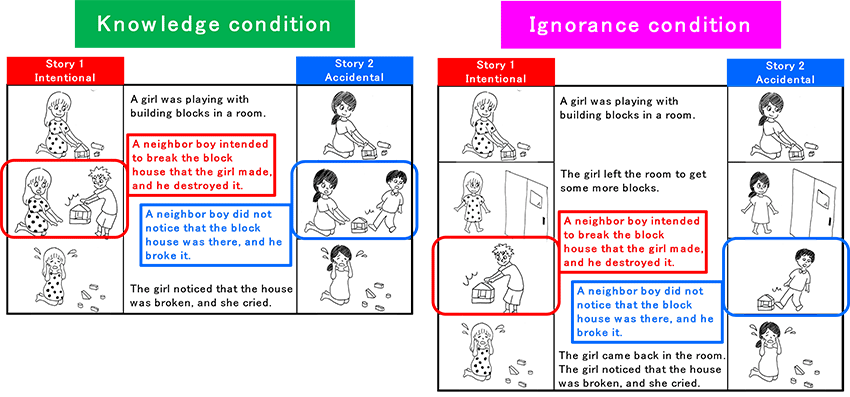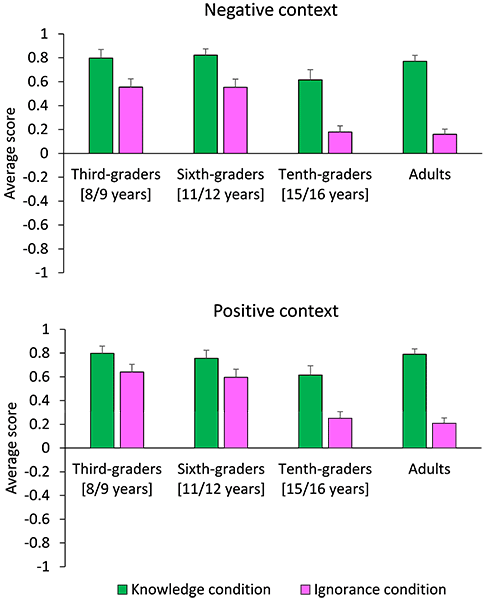People of all ages tend to misjudge the strength of other people's emotions based on an egocentric bias, according to a new study by Associate Professor Hajimu Hayashi, Kobe University Graduate School of Human Development and Environment. The findings were published on June 1 in the Journal of Experimental Child Psychology.
Even if the end result is the same, the recipient of an action usually responds with stronger emotions if the actions are intentional rather than accidental. For example, if we compare a scenario in which B intentionally destroyed A's treasured possession in front of A with a scenario in which B accidentally destroyed the possession, we assume that A is sadder if the action was intentional. In this case A sees B's actions, so A knows B's intentions. If A did not know B's intentions, A would feel the same amount of sadness in both cases. But if we as a third party judge that A is sadder if B intentionally destroyed A's possession, we are interpreting another person's emotions based on knowledge that only we have (the intentions of B), and egocentric bias is taking place.
This study looked at whether egocentric bias occurs in emotional understanding, and potential differences based on age and positive or negative contexts. The participants were 106 children age 8-9, 108 children age 11-12, 122 children age 15-16, and 154 adults.
The research team prepared four pairs of stories. Two pairs featured negative context in which the protagonists were harmed by the actors and felt sad, and the other two pairs featured positive contexts in which the protagonists were helped by the actors and felt happy. The only difference between each pair of scenarios was whether the actions were intentional or accidental (see Figure 1).

Two conditions were prepared in terms of the knowledge or ignorance of the protagonists. In the knowledge condition, the protagonists in both stories watched the actors and therefore knew that the actors intentionally or accidentally harmed or helped. In the ignorance condition, the protagonists in both stories did not watch the actors and therefore did not know their intentions. After some fact-checking questions, the researchers quizzed the participants with questions about emotional understanding, such as "Which girl is sadder at the end of each story?"
Scores were assigned based on the results of these questions, and they calculated average scores for two pairs of the stories in each of the negative and the positive contexts (Figure 2).
- +1: The participant judged that the protagonist was sadder when the harm was intentional (negative context) or happier when the help was intentional (positive context)
- -1: The participant judged that the protagonist was sadder when the harm was accidental (negative context), or happier when the help was accidental (positive context)
- 0: The participant judged that both protagonists are equally sad (negative context), or equally happy (positive context)

Average scores in the knowledge condition (in which the protagonists were aware of the actors' intentions) were significantly greater than 0 for all age groups in both contexts (Figure 2 green), confirming a general trend to judge the feelings of the recipient to be stronger when the actions are intentional. In the ignorance condition (in which the protagonists were ignorant of the actors' intentions), they should feel the same whether the action is accidental or intentional, so logically the average scores should be 0. However, the average scores were significantly greater than 0 for all age groups in both contexts (Figure 2 pink), revealing that some participants interpret the protagonists' emotions based on information that the protagonists do not possess. This shows that people of any age may demonstrate an egocentric bias when interpreting the feelings of others, although this bias is stronger in younger children. There was no significant difference between the score for negative and positive contexts, so the type of emotion does not affect the level of bias.
Understanding the emotions of others is the key to social behaviors such as smooth communication and helping others. This study reveals that our understanding of the strength of other people's emotions can be distorted by the information we possess. This may lead to miscommunication and have an effect on actions like offering help and comfort. Let's put ourselves in the position of the actors in this study: if we accidentally harm someone else, we may wrongly assume that his/her feelings of sadness are weaker even if he/she is ignorant of our intention. Quarrels between children over trivial matters may also occur because of this sort of egocentric bias. This bias is particularly strong in children up to elementary school age, so adults can use their awareness of this in education and guidance for child socialization.
Acknowledgements
The research team thanks the teachers at Kobe University Secondary School for their help in coordinating the data collection. This research was supported by Japan Society for the Promotion of Science (JSPS) KAKENHI [Grant Number 15K04065, 18K03065] to Hajimu Hayashi.
Article information
- Title
- "Egocentric bias in emotional understanding of children and adults"
DOI:10.1016/j.jecp.2019.04.009
- Author
- Hajimu Hayashi
- Journal
- Journal of Experimental Child Psychology






